A recent tunnel-related death raises more questions, and heeds the call for stricter safety measure adherence. Is convenience worth a life? Recently, I was reading a news story of a plumber who died in a tunneling accident. This particular story involved a plumber in Louisiana working in a tunnel underneath a home, when it collapsed Read more
plumber
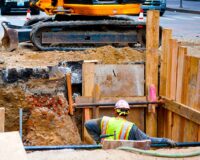
A recent tunnel-related death raises more questions, and heeds the call for stricter safety measure adherence. Is convenience worth a life?
Recently, I was reading a news story of a plumber who died in a tunneling accident. This particular story involved a plumber in Louisiana working in a tunnel underneath a home, when it collapsed, leaving the plumber trapped some four feet underground. According to Local 4 News, “emergency crews worked for over an hour and a half to free him. Firefighters also pumped fresh air into the collapsed tunnel in an attempt to help, but he did not survive.”
Now I hear about these stories from time to time, and ask myself, how do these incidences keep popping up? Are proper safety precautions and procedures put in place? Does it happen more often than we think? We are not passing judgment for this particular incident, but it is tragic, nonetheless.
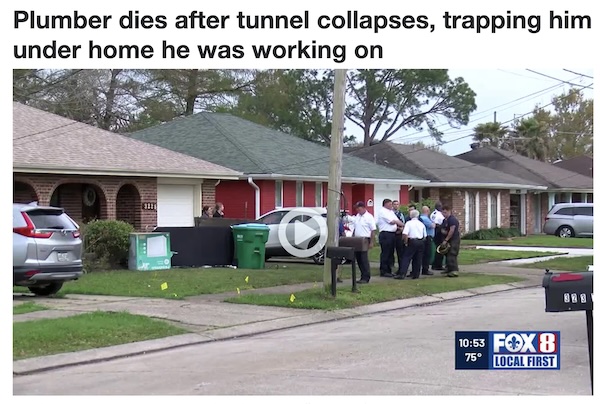
“An analysis by the National Institute for Occupational Safety and Health (NIOSH) suggests that excavation cave-ins caused approximately 1,000 work-related injuries each year, with about 140 resulting in permanent disability and 75 in death. When you consider confined space issues like asphyxiation, that number increases,” says Rachel Housman, CSP, CIH, and creator of Ally Safety, a provider of safety training and resource based on Occupational Safety and Health Administration (OSHA) requirements with a fun, modern twist for heavy industry. So, it does happen more often than we think.
According to information provided by OSHA, soil is heavy, and a cubic foot can weigh as much as 114 pounds, and a cubic yard can weigh more than 3,000 lbs. Most workers don’t realize the force that will hit them when a cave-in occurs. A person buried under only a few feet of soil can experience enough pressure in the chest area to prevent the lungs from expanding. Suffocation can take place in as little as three minutes. Heavier soils can crush the body in a matter of seconds.
For trenches between 5 feet and 20 feet deep, OSHA says shoring and sheeting, shielding, sloping and benching are all acceptable protective measures. It is up to the planners of the construction project and the competent person on site to determine which systems will work best. If an excavation is greater than 20 feet deep, a registered professional engineer must design the protective system.
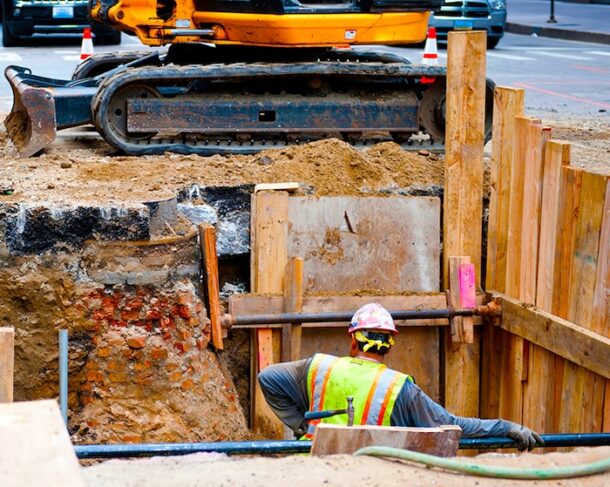
Shoring systems are structures of timber, mechanical, or hydraulic systems that support the sides of an excavation which are designed to prevent cave-ins. Sheeting is a type of shoring that keeps the earth in position. It can be driven into the ground or work in conjunction with a shoring system. Driving sheeting is most frequently used for excavations open for long periods of time. Another type of sheeting, in which plates or shoring plywood is used in conjunction with strutted systems such as hydraulic or timber shoring. These strutted systems are also referred to as active systems. The most frequently used strutted system involves aluminum hydraulic shores which are lightweight, reusable and installed and removed completely from above ground.
A shield, also known as a trench box, is another common protective system used by contractors. Trench boxes are not designed to prevent cave-ins, but rather serve to “shield” workers within the structure should a cave-in occur. This is an excellent choice when placing continuous installations, as in pipe laying. The box is placed in the trench and dragged along with the progress of the work.
The excavation and trenching standard from OSHA along with when a space will also qualify as a confined space are guidelines—let’s review:
Excavation and Trenching
• If a trench is 5 feet (1.5 meters) or deeper, a protective system must be used unless the excavation is entirely in stable rock.
• If a trench is less than 5 feet deep, a competent person must evaluate it for potential cave-in hazards.
• If a trench is 4 feet or deeper, and there is potential for a hazardous atmosphere, the air must be tested before workers enter.
Employers should also ensure there is a safe way to enter and exit the trench. Keep materials away from the edge of the trench. Look for standing water or atmospheric hazards. Never enter a trench unless it has been properly inspected.
Confined Space
It’s also considered a confined space if it meets all three qualifications below:
• Large enough to enter and perform work
• Limited means of access and egress
• Not designed for continuous human occupancy
Trenching on jobsites without proper safety precautions can’t possibly be done knowingly, right? “I think the disregard for safety is everywhere and is constant but largely unintentional. Unless you work for a big business or are part of a good union, you’re unlikely to get in-depth safety training on a regular basis. Lots of small businesses don’t know what they don’t know and OSHA doesn’t have the budget to do as much outreach as would be beneficial. Because of that, safety training actually becomes a privilege instead of a right. That’s a big part of why I do my YouTube channel,” says Housman.
So why then do good, knowledgeable people choose not to use cave-in protection? According to OSHA, lately the answer from employers is that cave-in protection would have been “inconvenient” to use. Is convenience worth a life?
Atlanta—Celebrating a century of excellence, innovation, and ingenuity, Rheem®, a leader in the water heating and HVAC/R industry, with manufacturing facilities in 88 countries, will showcase the culmination of 100 years of engineering at the 2025 AHR Expo. Rheem’s family of 50 global brands — including Rheem Heating & Cooling, Rheem Water Heating, Eemax®, Friedrich®, HTPG®, IBC™, Nordyne®, and Raypak® — will present Read more
Atlanta—Celebrating a century of excellence, innovation, and ingenuity, Rheem®, a leader in the water heating and HVAC/R industry, with manufacturing facilities in 88 countries, will showcase the culmination of 100 years of engineering at the 2025 AHR Expo. Rheem’s family of 50 global brands — including Rheem Heating & Cooling, Rheem Water Heating, Eemax®, Friedrich®, HTPG®, IBC™, Nordyne®, and Raypak® — will present a range of dependable, cutting-edge, and environmentally friendly product options designed for commercial and residential use.

Stop by the RIDGID booth to try out their latest drain cleaning, diagnostic, and pressing solutions ELYRIA, OHIO – February 11, 2025 – RIDGID®, a part of Emerson’s professional tools portfolio, announced their participation in the WWETT Show, Feb. 18-20, in Indianapolis. This year’s in-booth experience will include demos of a new game-changing handheld cordless drain Read more
Stop by the RIDGID booth to try out their latest drain cleaning, diagnostic, and pressing solutions
ELYRIA, OHIO – February 11, 2025 – RIDGID®, a part of Emerson’s professional tools portfolio, announced their participation in the WWETT Show, Feb. 18-20, in Indianapolis. This year’s in-booth experience will include demos of a new game-changing handheld cordless drain cleaner, along with their latest underground technology and pressing solutions, an exclusive show meetup for industry pros with the chance to win one of three RIDGID tools, and the first chance to enter to win a spot at the 2025 RIDGID Experience.
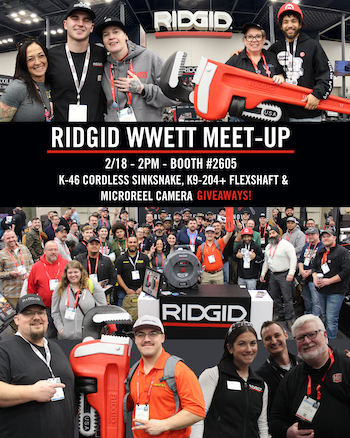 “WWETT will be the first place to experience our new K-46 Cordless SinkSnake™, a handheld drain cleaner that features an industry-first integrated, multi-position kickstand that alleviates the challenges of working under cramped vanities and in tubs,” said Jeff Albertini, product management director, underground technologies and licensing, RIDGID. “It’s been designed to significantly improve ergonomics when drain cleaning in sinks, tubs, vanities, and showers and our team is excited to be able to share it with those attending WWETT.”
“WWETT will be the first place to experience our new K-46 Cordless SinkSnake™, a handheld drain cleaner that features an industry-first integrated, multi-position kickstand that alleviates the challenges of working under cramped vanities and in tubs,” said Jeff Albertini, product management director, underground technologies and licensing, RIDGID. “It’s been designed to significantly improve ergonomics when drain cleaning in sinks, tubs, vanities, and showers and our team is excited to be able to share it with those attending WWETT.”
Along with the K-46, RIDGID invites tradespeople to stop by the RIDGID booth (#2605) to experience their other drain cleaning, inspection, pipe rehabilitation, and pressing tools, including these latest solutions:
o NEW SeeSnake® microDRAIN APX CSx Via™ System – This kit features the SeeSnake microDRAIN APX, an inspection camera ideal for small pipes and tight turns with a flexible push cable and compact camera head to navigate small-diameter pipes, p-traps, and narrow bends where other systems struggle. Equipped with TruSense® technology and auto-image rotation, this inspection camera provides bright, clear images with real-time angle and orientation feedback. Paired with the CSx Via, the system offers a flexible, bring-your-own-screen solution to stream, capture, and share inspection images.
o FlexShaft® KM-1004 Milling Machine – This innovative hybrid milling machine provides heavy-duty milling and a wall-to-wall clean on 1 ¼ to 4-inch pipe up to 80 feet with unmatched efficiency. With cordless freedom, plug-in capability, first ever FlexShaft cable counter, and best-in-class durability, the FlexShaft KM-1004 Milling Machine allows users to adapt to tough jobsite conditions and makes in-field serviceability effortless.
o SeeSnake Mini Pro Inspection Camera with TruSense Technology – The first reel of its kind to provide digital self-leveling without mechanical rotation to maximize uptime, the small, yet rugged Mini Pro is designed to inspect up to 200 feet of 1 ½ to 8-inch pipe with its mid-flex push cable that can navigate hard 90-degree bends. Its innovative 25 mm digital self-leveling camera head always keeps the in-pipe image upright and, when paired with a TruSenseenabled monitor, the Mini Pro delivers the industry’s best in-pipe image with superior clarity, detail and fewer blown-out areas and sections of the pipe that are too dark to see.
o K-4310 FXP™ Drum Machine – The K-4310 features an industry-first cable counter that provides real-time, in-pipe cable distance in 3 to 10-inch lines for faster locating and diagnostics. Ideal for residential and commercial plumbing and drain cleaning projects, its powerful brushless DC motor spins at 230 RPM allowing you to tackle tough jobs with less required maintenance. The battery-powered K-4310 is also the newest addition to the FXP Technology Platform, delivering cordless freedom and powerful performance.
Other RIDGID drain cleaning, diagnostic, and press tools will also be available for demo including sectional machines, drum machines, jetters, SeeSnake® camera systems and locators.
Along with product demos, RIDGID is hosting a booth meetup on Feb. 18 at 2 p.m. where industry pros will have the chance to win a K-46 SinkSnake™, K9-204+ FlexShaft® Drain Cleaning Machine or microDRAIN APX and Via Kit. Additionally, the first day of the show will kick off the RIDGID Experience 2025 and the RIDGID WWETT booth will be the first opportunity for attendees to enter for their chance to win a spot on the eighth annual, all-expenses-paid trip to RIDGID headquarters. Throughout the show, attendees can also scan their badge to enter to win one of three K9-102+ FlexShaft Drain Cleaning Machines.

Still crushing it 40+ years into the plumbing trade, Susan Jacobs-Marshalsea, Ms. Fix It Plumbing LLC, Foxborough, Mass. (@plumbersue on Instagram) says it’s that love of plumbing that still motivates her to this day. And there are really no plans of slowing down as of yet, “It’s probably the adrenaline that kicks in so the Read more
Still crushing it 40+ years into the plumbing trade, Susan Jacobs-Marshalsea, Ms. Fix It Plumbing LLC, Foxborough, Mass. (@plumbersue on Instagram) says it’s that love of plumbing that still motivates her to this day. And there are really no plans of slowing down as of yet, “It’s probably the adrenaline that kicks in so the physical aspect of plumbing sometimes gets ignored by my body because my brain just tells me to do it. Customers with emergencies and/or plumbing issues still excite me. I will plumb as long as I can physically,” says Jacobs-Marshalsea.

And that’s a good thing. You see, Jacobs-Marshalsea has been a staunch advocate for women in the trades. “Did you know that only 3.5% of plumbers are women. Did you also know that only 2.2% of electricians are women, only 3% of tile/carpet installers are women and less than 2% of carpenters are women? I don’t know why the percentage is so low,” says Jacobs-Marshalsea. “This is why I have become overly obnoxious in my Facebook and Instagram posts. Hopefully, other women seeing me plumb may encourage/entice them to think about a trade as a career.”
When asked about what we can do as an industry to help bring women into the trades, “Exactly what you did with asking me these questions,” she says. “We women need to put ourselves out there and promote ourselves and by having news interviews, publication interviews, promote workshops/trade shows and speak at local middle/high school career fairs—anything that helps get the word out that women can be in this trade, and that we are very good at it for various reasons.”
 Jacobs-Marshalsea says she really doesn’t “fight” any stigma today as far as being a woman in the trades. “I did 40+ years ago in the late 1970s, early ’80s. There weren’t many female tradeswomen back then, especially in the private sector. I’ve made a name for myself and have a great customer base and get referred often so I feel I have proved myself decades ago. Now I’m just the pink plumber lady, locally.”
Jacobs-Marshalsea says she really doesn’t “fight” any stigma today as far as being a woman in the trades. “I did 40+ years ago in the late 1970s, early ’80s. There weren’t many female tradeswomen back then, especially in the private sector. I’ve made a name for myself and have a great customer base and get referred often so I feel I have proved myself decades ago. Now I’m just the pink plumber lady, locally.”
But does Jacobs-Marshalsea consider herself a mentor? She’d love to mentor but very few women/girls are interested in plumbing, she says. “I think it’s the poop thing. And we all know that unless you are a drain cleaner, plumbers only come across ‘poop’ maybe 3-5 a month.”
Jacobs-Marshalsea teaches Plumbing 101 workshops to condo/homeowners, real estate agents, youth groups, parent/child, married couples, etc. so that she will have something to do, and a form of income, during retirement. “I started teaching because of the shortage of tradespeople—just little plumbing knowledge and repairs,” says Jacobs-Marshalsea.
The Beginnings
As fifth generation Master Plumber in Massachusetts, it was a no-brainer for Jacobs-Marshalsea. Jacobs Plumbing started in 1895 in Boston and her father was her mentor. “At first, he didn’t think women could plumb—late 1970s—but after a few jobs, he decided that I had the capability to do anything I set my mind to,” says Jacobs- Marshalsea.
After her father became ill and closed his business after 50 years, Susan started her own business in 2015 as S Jacobs Plumbing LLC. Susan rebranded and renamed her business around 2018 and Ms. Fix It Plumbing LLC was born. It’s as strong as ever, even more so during and after pandemic. “I assisted my father for more than 30 years in handling all aspects of his business—up to 15 guys, all the business stuff, running jobs, employees, advertising, fleet maintenance, etc—so when he closed his business I was fully up and running with my own in under a week,” says Jacobs-Marshalsea.
Today, with more than 600 residential/commercial/industrial customers, Susan has never not had her phone ring. She takes pride in still having a live-person, 24-hour answering service that she has used for more than 40 years, which helps people know that she will receive their message. “There is something about a customer calling and actually speaking with a live person, especially with an emergency, that eases their minds,” says Jacobs-Marshalsea.
 “I receive that call via email within 10-30 seconds of them hanging up. I then text them within 2-4 hours, depending on the plumbing issue or if they are an existing customer. I then have them send photo(s)/video(s) of their plumbing problem and can diagnose within minutes of what needs to be done.”
“I receive that call via email within 10-30 seconds of them hanging up. I then text them within 2-4 hours, depending on the plumbing issue or if they are an existing customer. I then have them send photo(s)/video(s) of their plumbing problem and can diagnose within minutes of what needs to be done.”
And while Jacobs-Marshalsea admits she loves plumbing and all it entails, surely there must be something she doesn’t care for, no? “Crawl spaces is probably my least favorite, but because I’m a small woman, I can get into most places male plumbers cannot. And, due to the shortage of tradespeople, specifically plumbers, the T&M rates (including flat rate) have been steadily increasing, so when someone asks how much something will be and I give them a guesstimate they are astonished and try to get me to lower my guesstimate, which is the thing I dislike about having a business or being a plumber. We protect the health of the nation and we are licensed and insured and are mandated to go to Continuing Education, so that frustrates me a lot,” says Jacobs-Marshalsea.
The Personal Side
When Jacobs-Marshalsea is not plumbing, she is working elsewhere, whether it’s in her gardens, getting ready for a workshop, volunteering for many non-profits, making improvements on her own home or offering to help someone else. “I find keeping busy keeps my mind sharp and my body flexible,” she says.

“But I’d like to take 30+ days and fly to California and rent a RV van and drive across America back to MA to see the country.”
Susan is finding that her social media is important for a handful of reasons. In addition to being informative, “People love to see me in my ‘yoga positions’ or ‘what to do or not to do’ or ‘helpful hints.’ Posting frequently lightens my day, and other’s as well.”
Finally, when asked when the last time she said, Today is a great day, “Every day is a great day— the sun came up and my feet hit the floor so when I leave somewhere I always say, ‘Have a great day!’”
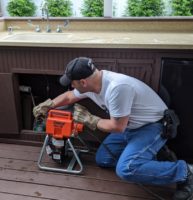
As a plumber, you will want to be as effective and efficient at the job as possible, so you can keep your customers happy and maximize your profits, right? Well, in order to do that, there are a few tools that you must be able to wield with confidence and precision, including the following: The Read more
As a plumber, you will want to be as effective and efficient at the job as possible, so you can keep your customers happy and maximize your profits, right? Well, in order to do that, there are a few tools that you must be able to wield with confidence and precision, including the following:
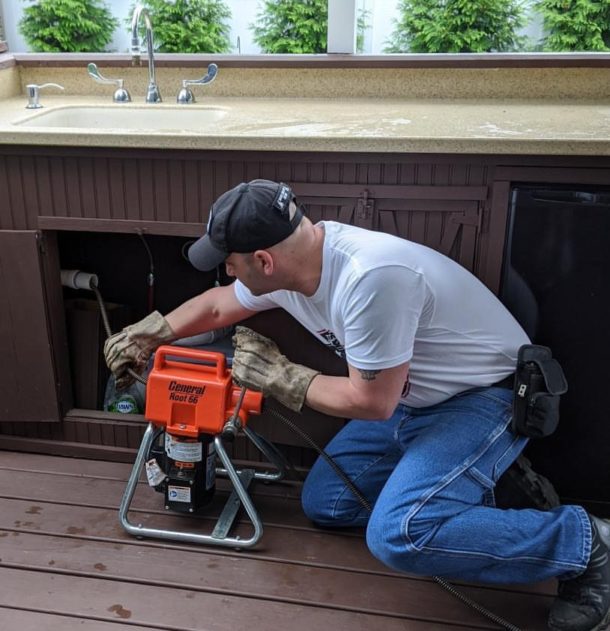
-
The Almighty Wrench
No plumber’s toolkit is complete without a wrench—or several, because size and type do matter here, folks. From adjustable wrenches to pipe wrenches, these are the bread and butter of plumbing. They twist, turn, tighten, and occasionally serve as an impromptu hammer (though we didn’t officially tell you that). Treat your wrenches like a knight treats his swords; keep them clean, dry, and ready for battle.
-
Plunger: The Suction Cup of Destiny
The humble plunger. Often underestimated, never overvalued. This tool is your first line of defense in the war against clogs. Be it a rebellious toilet or a slow-draining sink, a good old-fashioned plunger usually puts things right. Plus, there’s nothing quite as satisfying as that ‘pop’ when the clog clears. Ah, the sweet sound of success!
-
Pressure Washing Equipment: The Power Player
Sometimes, a job requires pulling out the big guns—or in this case, the big hoses. Pressure washing equipment isn’t just for cleaning driveways or stripping paint; it’s a game-changer for blasting through tough clogs in main sewer lines. It’s like the pressure washer is saying, “I find your lack of flow disturbing,” before restoring order to the galaxy… or at least to your pipes.
-
Hacksaw: The Rough Rider
When you need to cut through metal or plastic pipes, screws, nuts, or bolts, a sturdy hacksaw is your go-to. It’s not the prettiest tool in the shed, but when you need to make a cut, it’s your best friend. Just remember to keep extra blades on hand because nothing dulls the mood quite like a dull blade.
-
Pliers: Grip It Good
Pliers are like your hand’s stronger, tougher older brother. They twist, pull, pinch, hold, and occasionally rescue smaller tools that have fallen into the abyss behind the sink. Locking pliers, especially, are indispensable for those moments when you need an extra hand.
-
Torch: Light It Up
Not just for late-night horror stories, a good torch (or soldering torch, if we’re being technical) is essential for any plumbing work involving copper pipes. Whether you’re sweating a joint or just trying to see in the dark confines of an under-sink cabinet, a torch brings light and heat to the job.
-
Toilet Auger: Go Deeper
Sometimes a plunger just won’t cut it. That’s when the toilet auger, aka the plumber’s snake, slithers in. Designed specifically for toilets, this tool lets you reach deeper into the drain to clear out those particularly awkward clogs that lie beyond the reach of traditional tools.
Equip yourself with these tools, and you’ll be ready to tackle just about any plumbing problem that flows your way, and that means your business will be all the better for it!
